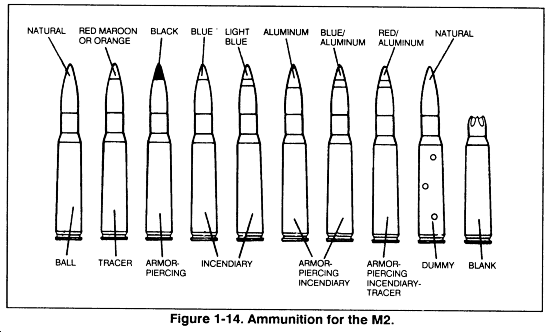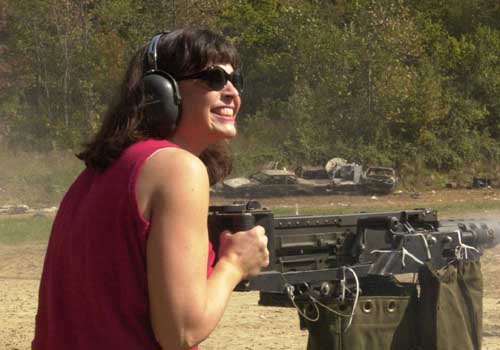The Browning .50 caliber (12.7mm)
M2 Machine Gun
"MA DEUCE"


M2 .50 on U.S.Navy river patrol boat (PBR), Go Cong River January 1967
The Browning M2 .50 caliber (12.7mm) Machine Gun, is a World War II era automatic, belt-fed, recoil operated, air-cooled, crew-operated machine gun. The M2 is crew transportable with limited amounts of ammunition over short distances. Also known as the Ma Deuce, it was originally developed around 1918. The M2 version came about in 1933 with an air-cooled barrel and no oil buffer; initially only 70 or 80 rounds could be fired continuously before the barrel would need to cool down for a considerable period of time. The HB (Heavy Barrel) version solved that issue and made the Ma Deuce a truly formidable weapon. The M2HB is still in service by the U.S. Armed Forces as well as by the British Army and a number of other countries.

Browning machinegun, Cal. .50 HB, M2
The belt feed mechanism uses disintegrating links and, by repositioning parts, can be adjusted for left or right feed. This gun is has a back plate with spade grips, trigger, and bolt latch release.The M2 is equipped with leaf-type rear sight, flash suppressor and a spare barrel assembly. By repositioning some of the component parts, ammunition may be fed from either the left or right side. A disintegrating metallic link-belt is used to feed the ammunition into the weapon.

The gun is capable of single-shot (ground M2), as well as fully automatic fire. As a heavy firearm it requires either a tripod mount (weighing in excess of 30 pounds) or other means of mounting. The weapon provides automatic weapon suppressive fire for offensive and defensive purposes. This weapon can be used effectively against personnel, light armored vehicles; low, slow flying aircraft; and small boats.

An American 50-caliber machine gun emplacement helps defend against Japanese air attacks at Guadalcanal.
The M2 machine gun on the M3 tripod provides a very stable firing platform. Together with its slow rate of fire and its traversing and elevating mechanism, the M2 was used effectively during the Vietnam war at fixed installations such as firebases. Snipers prefired the weapons at identifiable targets and worked the data into range cards insuring increased first-round accuracy. The 1st battalion, 5th Infantry, 25th Infantry Division constructed 20-30 foot high shooting platforms, adding steel base plates and posts to further stabilize the M2 on the M3 tripod. Together with the use of Starlight night vision scopes, the M2 severely limited enemy movement within 900 yards (1,000m) of the perimeter of a firebase.


M2 in action by US Soldiers
The .50 Calibre Browning Machine Gun is a robust and capable weapon and is used in a variety of roles such as close in AA Support and against light surface targets at close range. It is ideal for providing covering fire for boarding parties.

THE BROWNING M2HB is quite simply one of the greatest machine guns ever designed, being efficient and very effective; easy to use and to maintain; and as suitable for installation in a tank turret as on aground tripod or an aircraft.

The M1 tank's .50-caliber machine gun
The coolest thing about the M1's weaponry is its advanced fire control system. An array of sensors constantly monitors the tank's tilt, the turret's motion and any gusts of wind, and a computer adjusts the gun accordingly to keep it aimed at its target. With this system, the M1 can take out other tanks while it's on the move. Less sophisticated tanks have to come to a full stop to hit targets reliably.
Further, it has been in front- line service for five decades and there is a large range of widely available ammunitton. Like all weapons, the design started with the cartridge.

An M2 Browning water-cooled .50-caliber machine gun is depicted in an antiaircraft-artillery (AAA) configuration on a three-legged-tripod—upported gooseneck pedestal mount. Note the spade grip configuration usually seen on this weapon. This gun is in action (the water hook-ups are attached). A spare drum magazine can be seen behind the gunner at the far right. This photograph was taken during the Operation Husky invasion of Sicily from early July to mid-August 1943.
When the United States Army arrived in france in 1917 it found a need for a machine gun firing a larger round than that used in contemporary rifles, which was required not only for use against troops but also for new tasks such as attacking tanks, balloons, and aircraft.
It proved impossible to convert any US weapon to take the 0.43in (I 1mm) round then being tested b'y the french, but at that point the US Army happened to capture some new Mauser anti-tank rifles with their ammunition.The excellence of the round was quickly recognized and a new United States O.5O" cartridge was rapidly developed along the same lines.
At the same time John Browning, one of the most famous gunsmiths in history, was called in to develop a weapon to take this new round, which resulted in the M1921AI machine gun.The design was refined in the early 1930s which led to the M2, but this was limited by barrel life, and a new, much sturdier barrel was quickly produced, resulting in the definitive M2HB (HB = heavy barrel).

The M2HB has seen service in fixed-wing aircraft; helicopters; a multitude of trucks and field cars such as jeeps. Land Rovers, fast strike vehicles and HMMWVs;as well as APCs and tanks. It has been manufactured in vast numbers and is still widely used, since its O.5O" high velocity round has both considerable range, greater carrying capacity than the 5.56mm rounds now used in rifles and light machine guns, as well as great accuracy since it is highly resistant to wind drift.

M2 .50 -.50 on PBR in Vietnam
The ammunition is widely available, having been manufactured in some 30 countries, and is still in production in at least 10 of them.

There is also a vast range of natures (ie, different types) with some countries still devoting research effort to producing new 0.50 caliber rounds.

One of the most recent of these developments was the Saboted Light Armor Penetrator (SLAP) round developed by the US Marine Corps in the middle and late 1980s. This uses a sub-caliber (0.30in [7.62mm]) tungsten carbide penetrator carried in a 0.50in (12.7mm) sabot, which breaks away as the round exits from the muzzle.This results in the penetrator having a much increased velocity (3,985ft/s [l,215m/s] compared to 2,900ft/s [883m/s]) giving it a very flat trajectory, thus enhancing both hit probability and armor penetration. SLAP rounds were used with great success during their operational debut in Operation Desert Storm in 1991.
   
SLAP ammunition is completely interoperable with M2 machine guns, but requires one of the new type of chrome-plated, stellite-lined barrels. Upgrade kits are also being marketed, mostly concentrating on quick-change, longer-life barrels fitted with noise suppressors. Indeed, the only challenge of any significance to the M2HB is coming from the new heavy cannon, such as the McDonnell Douglas ASP 30mm,although these are very much larger and considerably heavier.

Another view of an M2 Browning water-cooled .50 caliber machine gun in an AAA configuration on a three-legged pedestal mount. Note the cradle for the operator to lean into and compare to the spade grips in the above photo. No water hookups are visible, but the ground directly beneath the mount is littered with expended shell casings. The photo was also taken in Sicily during 1943.

A U.S. soldier of the 101st Airborne Division (Air Assault) mans a .50-caliber machine gun during Operation ANACONDA combat in the Shah-e-kot mountains in eastern Afghanistan.

Sgt. Douglas D. Tompkins of Jud, North Dakota, Tank Company, 5th RCT, 24th U.S. Infantry Division, fires a .50 caliber machine gun at Communist-held positions during an assault against the Chinese Communist forces along the east central front, Korea. 14 July 1951.

Loading Mustang
 
  
|









